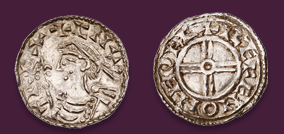
Auction: 6025 - Orders, Decorations, Campaign Medals & Militaria
Lot: 202
A Carnegie Hero Fund Large Bronze Medallion to Duncan Campbell, an Islay Farmer, Who Rescued Four Seamen from the Steamship Ena, Wrecked on the Isle of Islay Carnegie Hero Fund, 90mm, reverse dated 1911 (Duncan Campbell. Strevenish Islay. 21st. October 1911.), extremely fine and rare Estimate £ 500-550´On the 20th October, 1911, the steamship Ena, of Kragero, ran on the rocks near the shore of the Mull of Oa, Parish of Kildalton, Islay, and latterly became a total wreck. The weather at the time was calm, but in the early morning of the 21st a strong gale rose and the ship was likely to break up. The crew of 18 men and one lady passenger had remained on board, but as the storm rose they took to the boats. The last boat, however, was driven by the waves from the ship´s side, leaving four men on board. The news was brought at daybreak to Campbell, a local farmer, by some of the shipwrecked sailors who had managed to reach the shore. He at once went to the scene of the wreck. The vessel was lying close in-shore, the bow some 40 to 45 yards from the land, which all along the coast is exceedingly rocky, and mid-way between there rose a huge rock considerably above high water mark, but which at the time was now and then swept by the immense waves. The bottom of the narrow between this rock and the shore consisted of large boulders, and the sea was rolling through this at a great rate. After four unsuccessful attempts, and by carefully avoiding being washed away by the waves, Campbell managed to rush through the water to this rock, to which, by means of a rope and an improved sling, he ultimately managed to transfer the shipwrecked men. Before this was done the tide had risen considerably, so that it was now impossible to rush across the narrow channel about 20 yards wide from the rock to the shore, while to swim was equally impossible. Fortunately, by this time more people had come down to the beach, and ultimately communication was established between the rock and the shore by means of a rope. By lowering themselves into the water and clinging to this, and proceeding hand-over-hand, they all ultimately reached the dry land. So frightful and terrifying was the passage, however, that not one of the foreign sailors would venture through until Campbell had shown them that it was possible to lower himself into the raging waters and reach the shore in safety. The last man, indeed, was washed off the rope near the shore, but was caught by several onlookers before he could be swept back into the sea. Witnesses were of the opinion that Campbell ran a great risk of losing his life in making the rescue, as he did not know how to swim.´ (Chief Constable of Argyleshire´s report refers, 25.11.1911) Campbell received the bronze medallion and the sum of 20 pounds from the Carnegie Hero Trust Fund.
Sold for
£900




